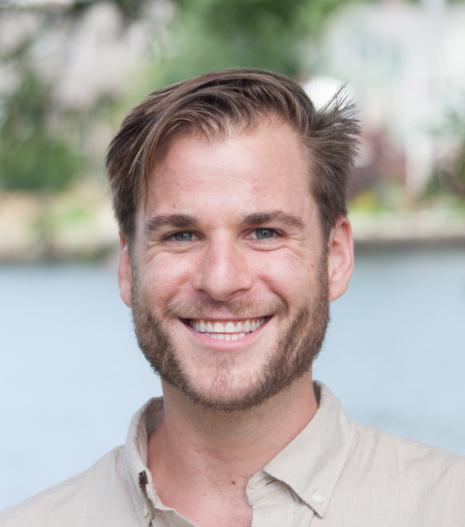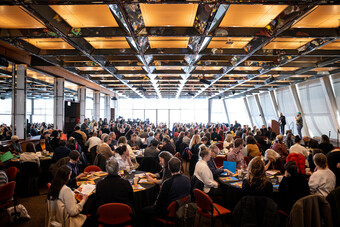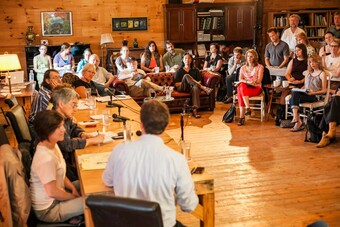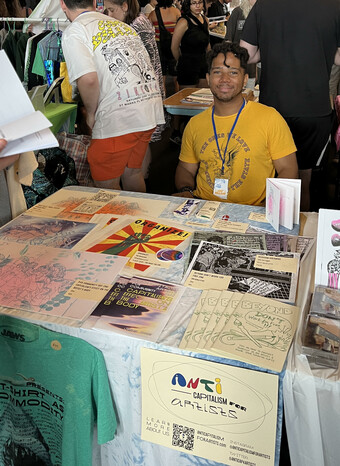How We Allow the Allowing
Access for Emerging Artists
It’s the allowing that art makes possible. We traditionally think that it’s the patron who gives the artist an allowance. Yet it’s the artist who gives society a large allowance. The artists give us the allowance to imagine things another way. —Letters to a Young Artist, Anna Deavere Smith
This book was given to me by a mentor, collaborator, and friend at the opening night celebration of my first professional production post college graduation. Five months later, transformed after a spontaneous move to Washington DC, to work in the Community Engagement department at Arena Stage, I finally broke the binding.
Reading on my boyfriend’s roof and watching the candy pink dusk of the DC sky float by, I got to thinking about how we allow the allowing, that is how and whom the system allows to make the art. Anna Deavere Smith’s letters often speak to power in art making. She argues that though it is vital to understand the system and “the man,” we must realize that as artists, we too have power. Yet, in a community that so often seeks to create art that reaches across boundaries and highlights the universal human experience, we must look beyond who has the power to make art (all artists) to examine how emerging artists gain access today.
Working to Make It Work
As a director and deviser, I am inspired every day. What I’ve found, however, is that those moments of fiery inspiration about what the art could be, the people I could reach, and the community I could gather are doused within minutes by the icy cold reality of needing money and connections to make art. Particularly for young, emerging artists working to make it work—taking on a nine to five job to pay the bills or finding other ways to make ends meet—financial resources are scarce for making work and building resumes.
It feels ever more imperative that as theatre moves forward as an enterprise, a commodity, a livelihood, a hobby—you name it—access to art making as an emerging professional is not limited to those that have the resources to fund their own work, bolster their resumes with unpaid internships (followed by unpaid fellowships, and unpaid assistantships) or attend astronomically expensive MFA programs that embed graduates in a web of networking possibilities. If financial barriers are allowed to prohibit the cultivation of artistic potential, what would have happened to August Wilson, an artist who left high school in an economically depressed neighborhood after being accused of plagiarizing his own writing? It is critical that young artists like myself are not led to believe that that not only theatre-going, but theatre-making has become an elite endeavor.

It is critical that young artists like myself are not led to believe that that not only theatre-going, but theatre-making has become an elite endeavor.
What I’ve Learned Can Help and 95 Empire
I found an unexpected glimpse of hope in downtown Providence where I now work in the incredible Education Department at Trinity Repertory Company. A mere block from the theatre, between my offices and the coffee shop that fuels my day, sits 95 Empire, the new multipurpose black box space in downtown Providence.
Formerly the home of the Perishable Theatre, 95 Empire is a program of AS220, a comprehensive arts community center in Providence supporting art of all forms, from culinary to visual. This allows 95 Empire to offer its theatre artists-in-residence the full resources of AS220, from printing programs and posters at the AS220 Print Shop to stocking a bar in the space with beverages from the restaurant next door, AS220 Foo(d). The support of AS220 also allows 95 Empire, given some limitations, to offer its presenting companies 501(c)(3) status through fiscal sponsorship. This allows artists to congregate around work, receive grants, and disperse again without going through the hassle and commitment of applying for not-for-profit status as an official company. In addition, AS220 has a loyal community of art makers and art consumers at its core. This not only means better chances of filling the seats in the theatre, it means that AS220 is, through its very existence, encouraging multidisciplinary work.
95 Empire allowed my theatre cooperative, the AntiGravity Theatre Project, a performance collective I cofounded with director Kym Moore, to develop and present our tour of Erik Ehn’s Yermedea Raw on its way to Soulographie at La Mama E.T.C. in New York. The residency allowed us to present every show as a pay-what-you-can performance. Without 95 Empire’s support, the art would not have been seen, our educational efforts would not have reached members of the community, and transformative dialogue would not have taken place. Simple as that.
The production of theatre at 95 Empire centers on their signature program, Residence@95. Artist-centric and affordable, Residence@95 offers emerging and seasoned artists alike the opportunity to share they work in a supportive environment with accessible prices. Here’s how it works:
For a two-week residency, the artist or guest company pays its first $500 in box office proceeds to 95 Empire each weekend. After this initial $1,000, 75 percent of the remaining box office proceeds go to the artist and 25 percent to the house (the theatre can hold up to 100 people). Ric Royer, Director of 95 Empire, curates the work in the space on a rolling basis and produces the art in an unjuried and uncensored model, meaning limitations and specific circumstances aside, no one is turned away. When all is said and done, the Residence@95 program is run on a first-come, first-served basis. Residence@95 allows artists to make their work cost-neutral. Since its induction, nearly every Residence@95 production has, at the very least, made back its rent in box office proceeds.
Part of the reason Ric can keep costs so low, even allowing those who cannot quite make ends meet to use the space, is because he has more than one need. “If a group can’t afford the cost, I can say, okay here are some other things that equal this cost. You are well positioned for sustainability as long as you make yourself moderately needy. It’s in a sense good to make yourself need more than just money.
And I need more than just money.” When young artists don’t have the financial resources, but perhaps have the time and skills that 95 Empire needs to maintain its space and producing model, they can still be awarded the opportunity to make their work. Bartering is not a dirty word at 95 Empire and can in fact lead to mutually beneficial, communally sustainable partnerships between artists and the producing body. Ric notes, “There is real economic stability in an unjuried model and a flexible model, if you align everything you are doing so that each work supports the others.”
Extreme affordability, the ability to exchange need in more than just currency, and expansive support cradled by an arts company and a community of artists in a state capitol? I mean, this is a pretty incredible model, right? Models like this are part of what we can do to ensure that all young artists are both empowered to grow and given access to do so.
Other Ideas, However Farfetched
I remember reading on several colleges’ Web sites that their admissions departments had conceived of a sort of equalization scale for AP courses and extracurricular activities. Whenever possible, the admissions officers would not penalize an applicant for attending a school that offered only a single AP class and a handful of extracurricular options when compared against a candidate who took eight of the nine AP courses available and participated in a wide range of after school activities. When considering artists for gigs or jobs in a theatre company, we could make a greater effort to take access to opportunity into account, not penalizing those who have less experience at fewer jobs when this is a product of needing to earn money to stay afloat.
I had the privilege of serving as one of the Community Engagement Fellows at Arena Stage in their 2010/2011 season. Arena’s Allen Lee Hughes Fellowship program offers its fellows one of the few almost cost-neutral intern/fellow/apprentice/assistantship programs in the country. My time there transformed me as an artist and educator, preparing me to tackle challenges and think in unabashedly big ways in my artistic life.
And yet, as theatre companies buckle down and cut costs across the country, internship stipends and benefits seem to always find their way onto the cutting board. While I understand the inclination, it seems as if in an ailing economy, it is these very (essentially) free labor positions that continue to support companies’ salaried structures. What if instead of cutting internship stipends and housing, artistic leaders made a commitment to instead make their internship programs more affordable while simultaneously reshaping the positions to fuel growth and engage new, younger, untapped audiences? What if we could create a system where our country’s best and brightest could vie for positions that were both vital to the future of companies and financially cost-neutral?
What if instead of cutting internship stipends and housing, artistic leaders made a commitment to instead make their internship programs more affordable while simultaneously reshaping the positions to fuel growth and engage new, younger, untapped audiences?
Lastly, and I realize this is perhaps the most farfetched, for those companies that produce seasons each year, a slot, a rehearsal room or a studio could be donated to young artists, say under thirty years old, to develop their own work. Or not even donated, but offered at reasonable rates that anyone could afford.
Sharing the Responsibility
I recognize that given the lack of resources and excess of expenses and worries, companies and producers do not always have the well-being of the young artist in mind. This of course makes sense. Especially in the not-for-profit sector, there is only so much generosity with resources, time, and space to go around. Thus, finding methods to present work created by young artists for young artists is vital to solving the problem of access. And young artists aren’t just standing idly by waiting for access to the art to find them.
My housemate and friend, a stage manager my age, told me of a group of young artists gathering together to present rogue Shakespeare in Central Park. They rehearse for one week and present the play outdoors, sometimes with each act in a different locale in the Park. They are able to present their work without the cost of space rentals or designer fees. I love this, because it is both a great idea and a solution devised by young artists for the sake of their own work and careers.
By no means am I suggesting that the onus of reshaping the current structure lies on established artists and companies alone. As young artists, we must figure out how to survive in the current landscape, how to embrace what Vanessa Garcia calls our “hybrid artist” identities. Zelda Fichandler saw a gap in how work was being created and funded, so she devised a solution. As young artists, we too are charged with this task. I’ve got my thinking cap on.
A Final Vow
To be an artist, one must have a wide expressive range and a profound desire to communicate. That desire to communicate has to be larger than the chains that bind...Don’t disregard your chains; don’t ignore them—use them to get stronger. —Anna Deavere Smith
I am beginning to get a grasp on how the system works. The past few years have taught me much about the reality of the expectations I had for this business and lifestyle. And yet, I still refuse to entirely accept the system or believe that my expectations were too high to begin with. Whatever chains I feel or see holding me or my peers back, they must be used to make us stronger.
For young artists are the future. When a young artist, eyes still wide open with hope and possibility, experiences a spark of genius, the system (young people included) must allow this spark to be cultivated, even in the smallest of venues with the smallest of budgets. We must empower the artists of tomorrow to make art today in order to hone their aesthetics, develop their voices, and maintain their hunger and will to fight. The future of our art and society depends on it.
And I vow, right here and now, to remember this decades down the line when “young” or “emerging” no longer qualifies my artistic identity.









Comments
The article is just the start of the conversation—we want to know what you think about this subject, too! HowlRound is a space for knowledge-sharing, and we welcome spirited, thoughtful, and on-topic dialogue. Find our full comments policy here
Great article! Wonderful ideas! I am an older emerging artist...but consider myself YOUNG at ART. I just attended the Playwright's Center's (Mpls) Unit Collective performance last evening and enjoyed every moment...watching artist of every age pour their hearts and energy into newly created work. I wanted to shout..Keep writing...keep making art and spreading the word...the world is full of artists (more are being born every day)...we need to create more opportunities to express art through every stage of our lives.
Preach. This article has eloquently summarized what I've been un-eloquently trying to say for a long time. Thank you for this.
As a soon-to-be-graduating college senior, I am inspired and encouraged by your words, Michael. However, I was literally just looking at the Arena Stage fellowship and wrote it off as unfeasible. It's a year long program with a "weekly stipend" (which I would assume is next to nothing) and no housing option. Several other programs at least offer housing in return for the lack of salary, given it's generally a 40 hr/week position. I'm just curious what you meant when you described it as "cost-neutral".
The fellowship offerings at Arena may have changed since the 2010/2011 season, but during my time there, each fellow was paid $300/week. This may no longer be accurate, but was indeed what I was compensated. My rent in NW DC was around $650/month, meaning food, travel to work and rent was possible to pay for with fellowship funds alone. This is what I mean by cost-neutral: that a fellow/intern/apprentice can work/learn while making enough money to not spend more than they are taking in to live.
Thanks for this great article! My work provides a two-year fellowship program to emerging visual artists and so I think about the things you talk about on a daily basis. The points you raise are super valid and I want to thank you for putting them out there. For me, it's no longer about emerging, emerged, old or young. I think EVERYONE - no matter where they are in their career cycle - desires to continually learn, experiment, showcase and grow in their work. For me, it gets interesting when we start to talk about the bigger picture... the art ecology and how we all relate to and engage with each other.
When selecting artists for our post-doc inspired fellowship program, we not only look at the quality of art they make, but also how do they use creativity to make their art and career happen? Basically, we are looking for their adaptability, level of dedication and resilience, as well as potential to excel. The responsibility for our fellowship program is then to support their answers unconditionally and find way to help them realize their very best potential.
This can be done is so many ways and I, therefore, wholeheartedly loved the point you made about sharing.... spaces, resources, experience, and sometimes even the spotlight. That is an essential starting point and to do that requires a conversation. It also requires asking for as well as offering something and not always in return. In my own career, I've often struggle with this myself. But I do believe that by putting my ideas, goals and dreams out there, creativity, daringly, relentlessly, and asking artists and organizations to share theirs with me , we are automatically creating more opportunities to learn, experiment, showcase and grow alongside and with each other. Very much like yours', my vow is to always seek this exchange of asking and offering.
Thanks for these insights. I have indeed equated “young” and “emerging” here. I actually had an email exchange about it with a fellow artist who read an earlier draft of the article. She expressed a similar concern with the meaning/implication of using “emerging” in this context. It suggests there exists some final destination for an artist’s career, right over the horizon at 30. This of course does not exist! I wanted to spark a conversation on access during an artist’s first years out in the world, and the few years after that - the sort of critical, developmental period at the beginning of an artist's professional journey. I just found “young” and “emerging” together to be effective words to describe this span of time. That said, I know from my three years of personal experience and from stories upon stories from mentors, that careers move forward in fundamentally unpredictable ways. If there exists an adjective that effectively refers to this period of time, that would indeed be more appropriate!
Michael, you bring up very good points here as well. And I now better understand your use of those words. I also wonder if there are different ways to describe those early stages of an artist's career. In fact, sometimes I wonder at what point do we describe what we do as a 'career.' What is that based on? How is that determined? By money,opportunity, level of visibility? And I only say that because often when I hear artists described as early career or emerging, they typically seem to be artists a lot further along than myself. So does that make me pre-career? These labels get very fuzzy and interchangeble in not good ways. For instance,over the course of a few months I heard two different descriptions about the same playwright - one was for a major award he recieved given to mid-career playwrights. The other was a press release from a theater company describing him as an emerging playwright. Huh? Which is it? And how do I find my place within those contradictions?
Michael, thank you for this and I agree with 99% of what you've said,
However, I strongly agree with Catherine, equating emerging with young (under 30) is very limiting to a great many artists. The doors of opportunity do not magically open when you turn 31. In many ways it actually gets harder. So identifying ways to support emerging artist of all ages is vital.
However, I love your idea about taking access to opportunity into account. And it is something I would love to see discussed more in the field. This is especially important in regards to career trajectories for playwrights and directors outside communities like NYC, Chicago, and perhaps Boston and Minneapolis.Playwrights and directors outside these communities typically create with fewer opportunities for professional and creative development. How can we solve this?
I like so many of your ideas. Except for equating "young" with "emerging." This creates a system where if you haven't "made it" by 30, or if you come to the art-making side of theater later (perhaps transitioning from performing) or if you take "gap years" in a career to raise kids--well, tough. The industry (the whole culture, really) takes a linear view of career development, but I know very few artists whose careers progressed in the expected way.